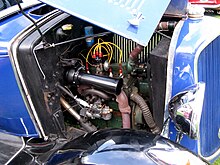Renault Monaquatre
| Renault | |
|---|---|
|
Renault Monaquatre (Type YN 1) Sedan (1932)
|
|
| Monaquatre | |
| Production period: | 1931-1935 |
| Class : | Lower middle class |
| Body versions : | Limousine , convertible , roadster , station wagon , pickup , panel van |
| Engines: |
Petrol engines : 1.3-1.5 liters (18.4-25 kW) |
| Length: | 3900-4400 mm |
| Width: | 1550-1600 mm |
| Height: | 1580-1610 mm |
| Wheelbase : | 2650-2660 mm |
| Empty weight : | Chassis: 650 kg |
| Previous model | Renault Monasix |
The Renault Monaquatre was a passenger car model of the interwar period of Renault . The type codes were Type UY and Type YN .
description
Renault presented the vehicle in 1931 as the successor to the Renault Monasix . In 1935 production ended without a successor.
Type UY
The first version received approval from the national approval authority on September 16, 1931. The water-cooled four - cylinder engine with a 66 mm bore and 95 mm stroke developed 25 hp from a displacement of 1300 cm³ . The vehicle was therefore considered to be 7 CV for tax purposes . The engine power was sent to the rear axle via a cardan shaft . The chassis had a wheelbase of 265 cm, a track width of 130 cm and weighed 650 kg. The turning circle was given as 11 meters. There were vertical vents in the sides of the hood. Four- door sedans as normal and luxe , faux convertibles with three to four seats, torpedo commercial , business sedans and panel vans have been handed down . The body of the sedan with a length of 390 cm and a width of 155 cm corresponded to the Renault Primaquatre , but the front bumper consisted only of a thin tube.
Type UY 1
This version for the period from 1932 to 1933 was limited to the four-door sedan and business sedan bodies. The front bumper was one piece and straight.
Type YN
This version was approved on September 3, 1932. A larger cylinder bore of 70 mm made for a displacement of 1462 cm³. This made the vehicle the 8 CV . A two-door sedan with a suitcase, a four-door sedan with or without a suitcase and a business sedan with a payload of 500 kg as well as the equipment lines Normal and Luxe were available .
Type YN 1
This model was marketed from December 1932. The engine developed 30 hp. The vehicles were 390 cm long and 157 cm wide. As normal there were four-door sedans and business sedans, as Luxe two- and four-door sedans and as Grand Luxe also two- and four-door sedans. At the same time, a two-tone, two-door sedan appeared with three ventilation flaps in the sides of the bonnet instead of the previous vertical ventilation slots. In the course of 1933, the other versions also adopted the flaps. From the beginning of 1933 there was also the type YN 1 SA variant with a different engine mounting. From February or March 1933, a four-door sedan with six side windows was also available.
Type YN 2
This version, presented in October 1933, had a slanted radiator grille, three ventilation flaps in the sides of the bonnet and initially a one-piece straight front bumper, which was later replaced by a bumper that was bent down in the middle. There was a choice of two- and four-door sedans, convertibles and business sedans .
Type YN 3
Presented in January 1934, the engine now developed 30 to 34 hp. The wheelbase was either 265 cm or 266 cm, depending on the source. The body was designed to be more aerodynamic and the spare wheel was mounted at the rear - neither of which applies to the business sedan. Sedans and roadsters with a jump seat have been handed down . The vehicles were 400 cm long and 160 cm wide.
Type YN 4
This version was presented in October 1935. The engine now developed 34 hp. The wheelbase measured 266 cm or 265 cm for the business sedan, the track width was 130 cm. The vehicles were between 437 cm and 440 cm long, 156 cm wide and between 158 cm and 161 cm high. Another source mentions a wheelbase of 265 cm, a vehicle length of 415 cm and a vehicle width of 160 cm. On offer were four-door sedans, roadsters with jump seats, convertibles and business sedans. Three to four ventilation slots on the sides of the bonnet were a visual distinguishing feature from older versions.
literature
- Gilbert Hatry, Claude Le Maître: Dossiers Chronologiques Renault. Tome 5: 1924-1933 . Editions Lafourcade, Paris 1981, ISBN 2-902667-06-X , pp. 160-219 (French).
- Gilbert Hatry, Claude Le Maître: Dossiers Chronologiques Renault. Tome 6: 1934-1934 . Editions Lafourcade, Paris 1982, ISBN 2-902667-08-6 , pp. 12-47 (French).
- René Bellu: Toutes les Renault. Des origines à nos jours . Éditions Jean-Pierre Delville, Paris 1979, ISBN 2-85922-023-2 , pp. 104-131 (French).
Web links
- Histomobile for Type YN 3 (English, accessed October 4, 2014)
- Histomobile for Type YN 4 (English, accessed October 4, 2014)
- voitures.renault.free.fr (French, accessed October 4, 2014)
Individual evidence
- ^ A b c Gilbert Hatry, Claude Le Maître: Dossiers Chronologiques Renault. Tome 5: 1924-1933 . Editions Lafourcade, Paris 1981, ISBN 2-902667-06-X (French).
- ^ A b c Gilbert Hatry, Claude Le Maître: Dossiers Chronologiques Renault. Tome 6: 1934-1934 . Editions Lafourcade, Paris 1982, ISBN 2-902667-08-6 (French).
- ↑ a b c d e René Bellu: Toutes les Renault. Des origines à nos jours . Éditions Jean-Pierre Delville, Paris 1979, ISBN 2-85922-023-2 (French).




